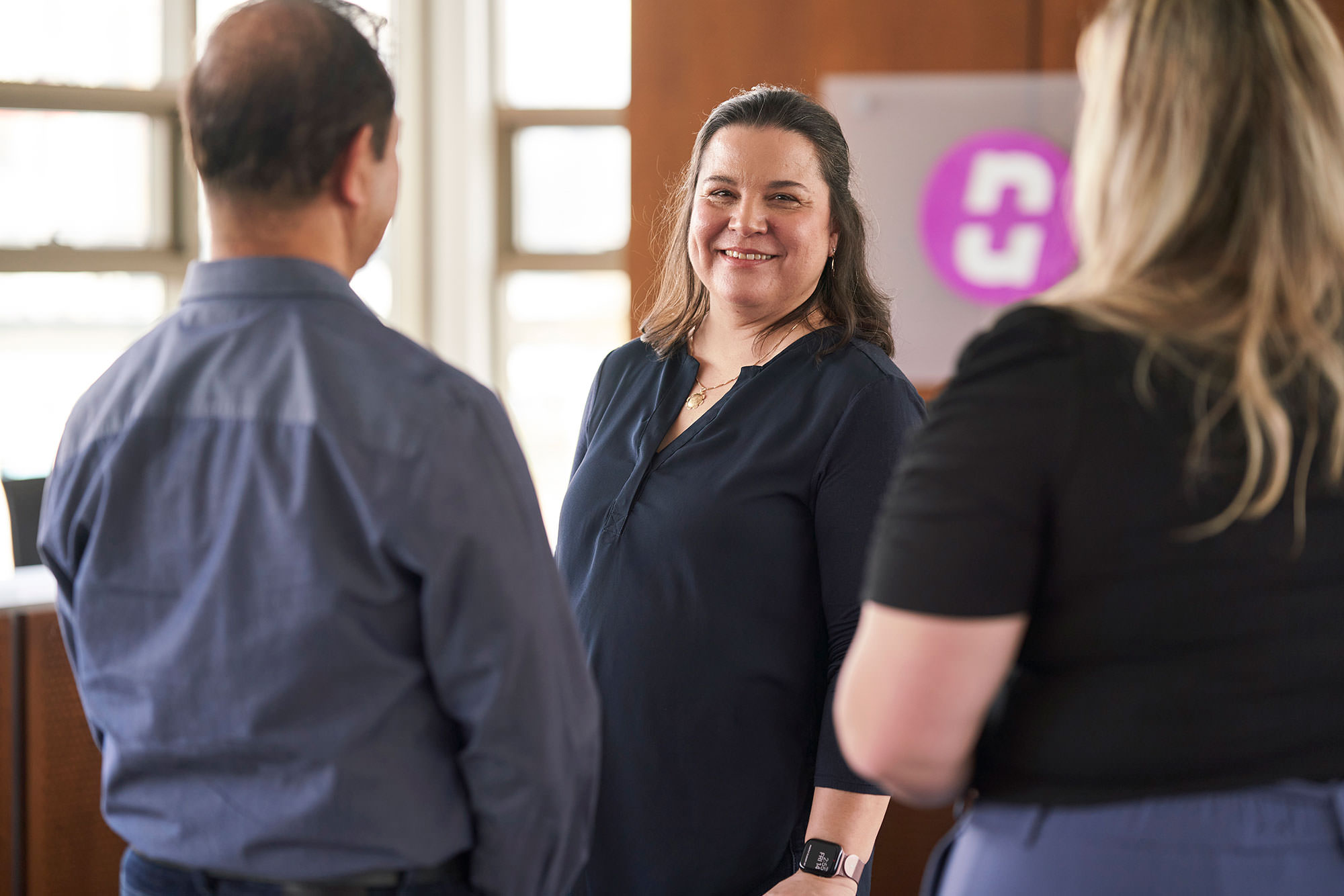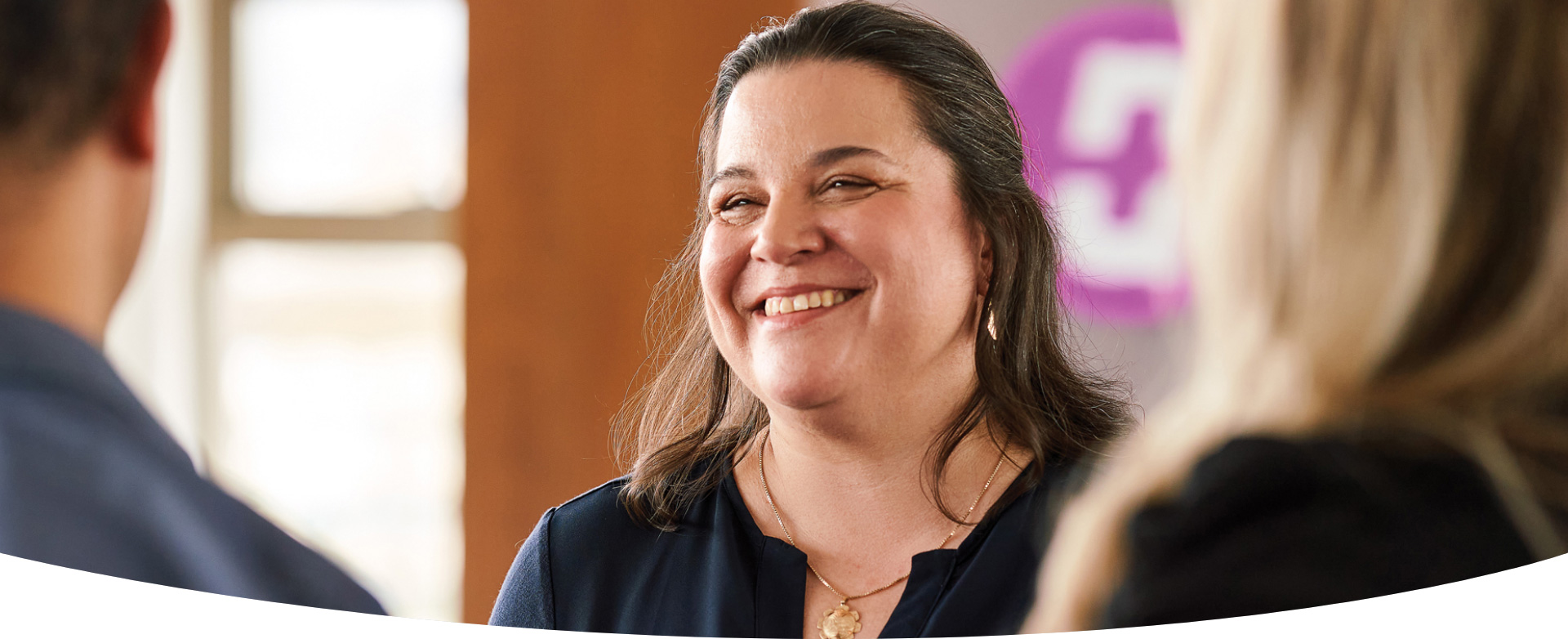MONIQUE PAT IS UNSTOPPABLE IN HER COMMITMENT TO ADVANCE CULTURAL SAFETY AND MAKE RECONCILIATION A REALITY.
The Victoria General Hospital Indigenous liaison nurse didn’t always aspire to a career in health care. A member of the T’Sou-ke and Namgis First Nations, her journey to nursing began when she heard of a care aide program being promoted by North Island College and three local First Nations in the territory of the Kwakwaka’wakw. She decided to apply and became one of eight people accepted into the program.
While working as a care aide, Pat met a Métis registered psychiatric nurse who told her about an online RPN program being offered by Stenberg College. The demand for RPNs across BC was high, particularly outside large urban centres. “The accelerated program allowed students to complete most of their coursework, clinical placements, and practicum in their own regions throughout BC,” Pat recalls. “I signed up and two years later I was a full RPN.” She began working as an Indigenous liaison nurse (ILN) for Island Health’s Department of Aboriginal Health in 2008 and was hired permanently one year later, after the health authority created a second ILN position for southern Vancouver Island.
Nursing runs in Pat’s family. Her father worked as a licensed practical nurse in the 1970s. As a young girl, she remembers going to work with him to visit the elderly. “They had no visitors,” she said. “My father thought it strange that these folks had no one with them, and he had me visit and act as a granddaughter to them.”
Today, Pat has almost 24 years of Indigenous health experience, ranging from home care, diabetes prevention and care, HIV/AIDS prevention and care, and coordinating health care throughout First Nations communities on Vancouver Island and at the Victoria Native Friendship Center.
In her ILN role, she helps patients in the community navigate the complexities of the health-care system while at the same time educating all health-care workers in the hospital and in the community about the importance of Indigenous cultural safety.
As an educator, Pat's work is grounded in critical race theory, which she says provides an understanding and analysis of the relationships that exist within settler colonialism and culturally specific Indigenous traditions.
For a First Nations woman, the task of explaining systemic racism and its effects to a white or non-Indigenous audience can be challenging, and Pat partners with Island Health and Provincial Health Services Authority cultural safety facilitator Laurie Harding to help broach difficult issues like power and privilege.
“We can't keep upholding cultural biases and normalizing white authority. Critical race knowledge, self-awareness and intervention skills, along with a deep commitment to allyship, are required when working with Indigenous people,” Pat explains.
“Policies in our institutions are set up for settlers and colonists, and they affect Indigenous people and people of colour,” she says. “Sometimes lives are lost because of a misunderstanding and biases, so we must stand up and begin to make changes required to make health care safe for all.
“It's a lifelong learning process, and all of us are going to be at different stages of development, just like nurses,” Pat explains. “Recently graduated nurses may not yet engage in critical thinking and likely won't until time has gone by, and they gain experience.
“It's the same with anti-Indigenous racism and cultural safety work. Undoing the past and getting to a place where we are healing together will be hard but essential work that takes time and effort.” She explains that practising cultural safety is a whole new way to approach health care that's also beneficial for patient care. “If we diminish, demean or dismiss others, then we are not safe.”
Pat is a member of the BCNU Indigenous Leadership Circle (ILC). The circle is one of four equity-seeking groups under BCNU's human rights and equity umbrella. ILC members promote cultural safety in the union and the workplace while working to dismantle the harmful effects of colonization and Indigenous-specific racism.
In 2019, the ILC put forward a resolution at the union's annual convention to establish the BCNU Truth and Reconciliation Committee (TRC), with a mandate to lead BCNU's reconciliation efforts. The resolution passed and a nomination process followed. Pat was elected as one of two ILC members to sit on the newly formed committee.
As an integral committee member, Pat works with BCNU council reps who are dedicated to addressing the ongoing impacts of colonialism on Indigenous people. They are also committed to implementing the Truth and Reconciliation Commission of Canada's 94 Calls to Action, which aim to address the harms caused by residential schools and advance reconciliation in the country.

Pat's family, like so many others, has been touched by the residential school system. In 1997, she found out that her father, along with other family members, attended the residential school in Alert Bay.
The TRC's efforts are currently focused on increasing awareness of the Truth and Reconciliation Commission's findings and advocating for education and understanding about the impacts of colonialism.
Pat says BCNU, having endorsed the report, has a responsibility to empower Indigenous nurses and to promote their well-being within the workplace while advocating for justice alongside them. By doing so, she says the union can help ensure the voices of Indigenous nurses are heard and respected.
Diversity, equity and inclusion – or “DEI” – initiatives are just the beginning of this process, she argues.
“Diversity is good to a point, but it doesn't 100-percent create that cultural safety for Indigenous people. It's going to take generations of understanding on how to walk up this hill together and doing the actual work that's needed to implement the 94 Calls to Action contained in the Truth and Reconciliation Commission's report,” she stresses.
“Truth and Reconciliation Commission Report chief commissioner Murray Sinclair said when introducing the document: ‘We have described for you a mountain. We have shown you the path to the top. We call upon you to do the climbing.' Now we must choose to climb the mountain he created from the hundreds of stories from those residential school survivors that the commission gathered as it went across Canada,” she says.
Pat argues that true reconciliation requires anti-Indigenous racism education and initiatives that identify systemic failures and directly address social inequality. “Anti-Indigenous racism and cultural safety is different from the multiculturalism approach,” she notes. “Anti-Indigenous racism acknowledges the systemic nature of racism as the norm, and actively confronts unequal power dynamics that Indigenous people in Canada face.”

Pat says the province's 2019 report In Plain Sight: Addressing Indigenous-specific Racism and Discrimination in BC Health Care was a stark reminder of that systemic racism, and the report's recommendations are also keys to assisting allies to step up and take the time to learn.
For BCNU's part, she says the union can embrace its Indigenous members by responding to the Truth and Reconciliation Commission's call to hire more Indigenous people. This would expand the safe spaces needed for Indigenous members and their allies to promote cultural safety and advance anti-Indigenous-racism education.
In the meantime, she hopes all of BCNU's 16 regions will engage in the work required to meet the Truth and Reconciliation Commission's 94 Calls to Action, reflect on the recommendations of the In PlainSight report and heed the call for justice contained in 2019's Reclaiming Power and Place: The Final Report of the National Inquiry into Missing and Murdered Indigenous Women and Girls.
Pat acknowledges there is much to learn, and much work to be done in the days and years ahead. But she encourages all members to learn more and embrace the reconciliation process.
“As a country, we are still learning the truth about Indigenous history. This includes a government-funded, church-run residential school system that took over every aspect of Indigenous people's lives,” she notes. “Now, the work that is needed to improve the lives of residential school survivors and their families must equal the harm that was done. This is the least that will be needed if we are to re-build equitable relationships with Indigenous members, patients and people in our communities.”
